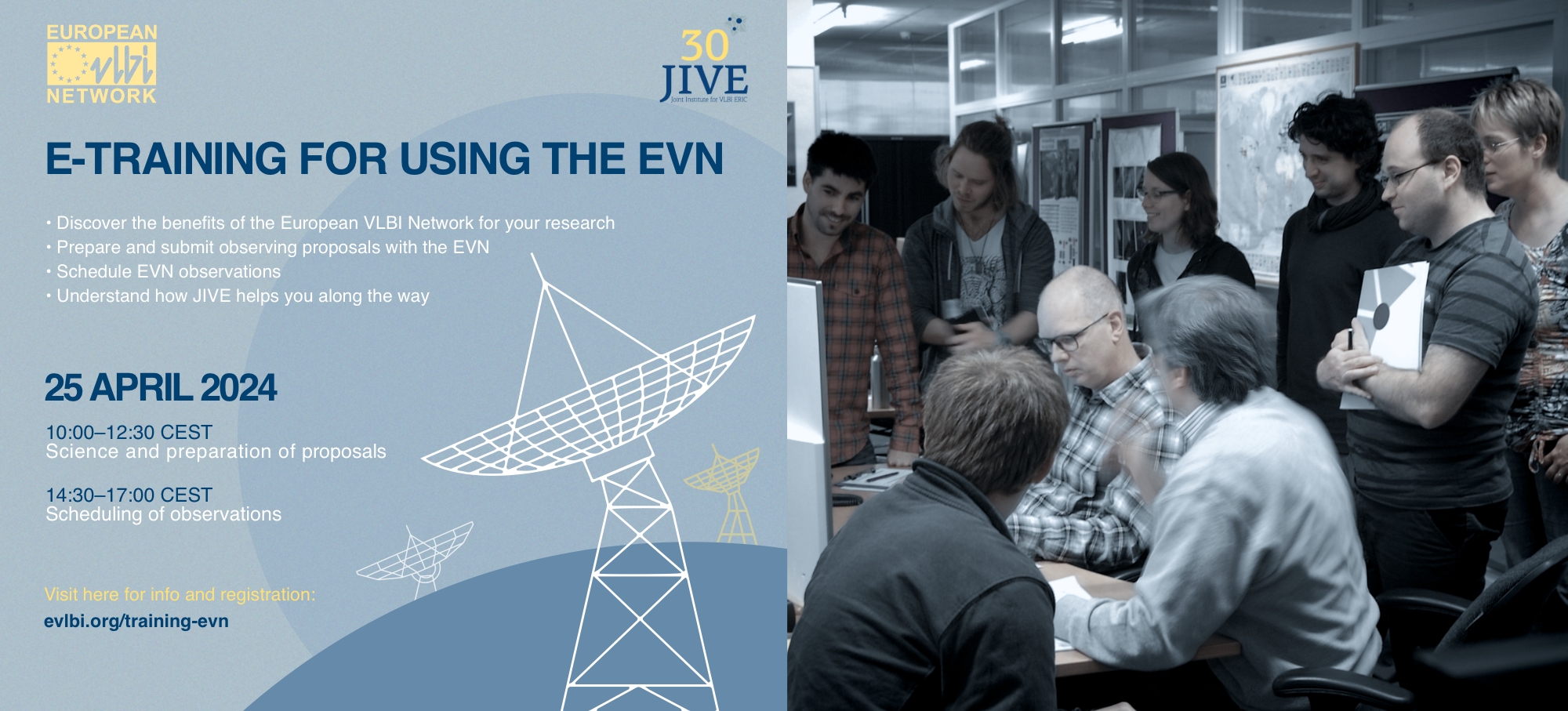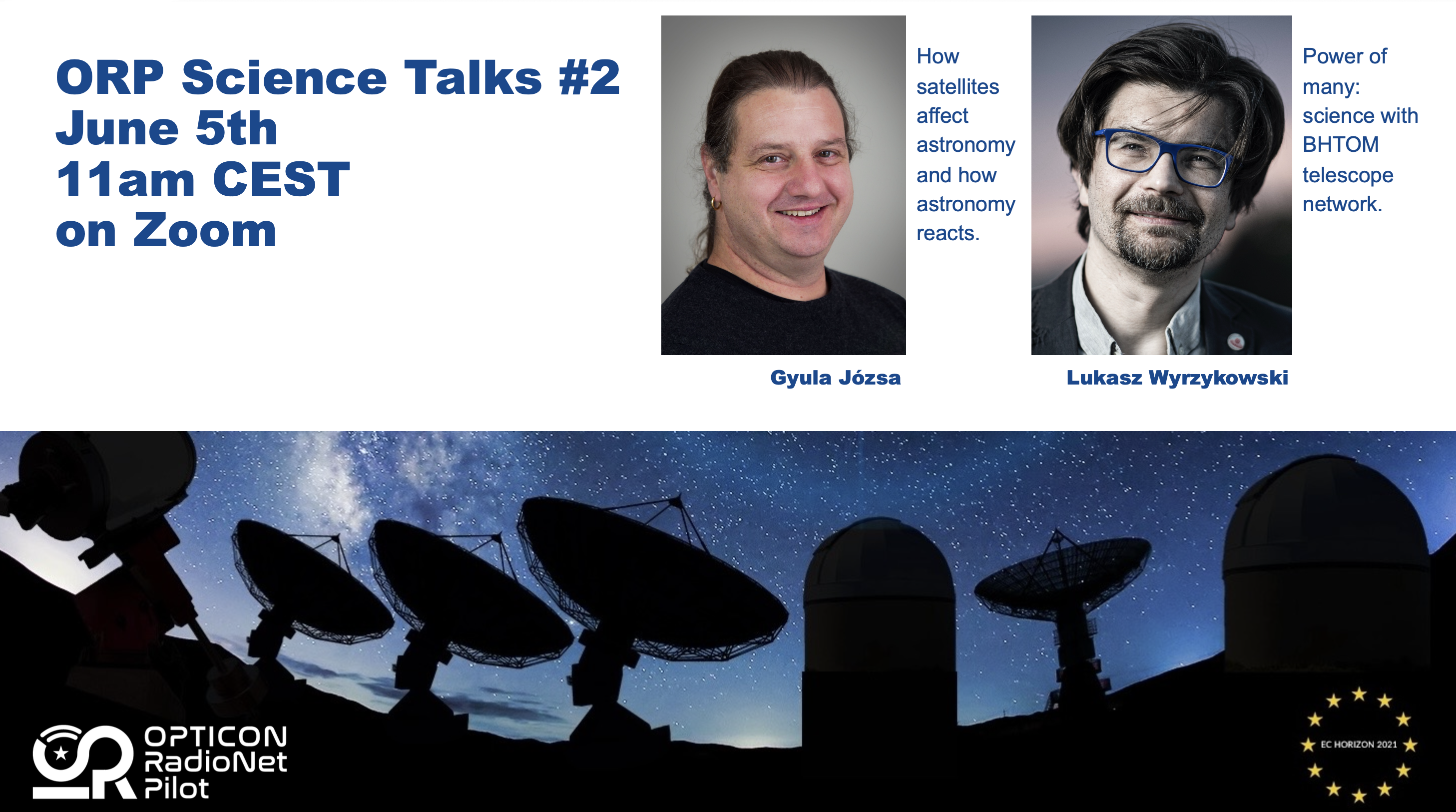
EVN/JIVE Newsletter - Edition 69 September 2024
Welcome to the September 2024 issue of the EVN/JIVE newsletter.
Next week many of us will be attending the 16th EVN Symposium in Bonn, hosted by the MPIfR and organised by Eduardo Ros and Andrei Lobanov.
The first EVN Symposium was held at Jodrell Bank in 1993 and we aim to host the 2026 meeting in Manchester and Jodrell Bank too.
It will be a packed programme in Bonn: the list of participants and the range of topics show the diversity and range of the EVN community and EVN science, with 164 participants from 25 countries. Science topics range from dwarf stars to high redshift quasars and multi-messenger projects following detections using gravitational waves and neutrinos. There will be an additional session on Monday evening to celebrate 30 years of JIVE, with presentations on the development and success of JIVE in promoting, supporting and advancing VLBI techniques for the EVN and more generally.
At the same time OAN Yebes in Spain will be hosting the 53rd YERAC meeting bringing young radio astronomers together to present their work to their peers. Running since 1968, YERAC provides a uniquely supportive and friendly environment for young scientists and establishes connections that span whole careers.
The EVN Directors and JIVE Council met in Torun in May, thanks to our host Krzysztof Katarzynski, Director of the Institute of Astronomy at NCU, Torun. It was encouraging to see the high number of EVN proposals in the last round, and the strong science output highlighted below, including the multi-scale view of the interactions of jets with their surrounding environment bringing together EVN, VLBA, e-MERLIN, VLA, and LOFAR data to span a wide range of scales in space and time. We also had a presentation from Koichiro Sugiyama on the new 40-m Thai National Radio Telescope, and we look forward to the future participation of that new telescope as an associate member of the EVN later this year.
Sadly, we also marked the passing earlier this year of Prof Roy Booth (Director of the Onsala Space Observatory from 1981 to 2005). Roy was instrumental in establishing the EVN in the 1980s and was always committed to its success. Roy was a passionate advocate for international cooperation in astronomy and was a champion for VLBI at all wavelengths.
Simon Garrington
Jodrell Bank Observatory, University of Manchester
EVN CBD Chair
 Observing proposals are invited for the European VLBI Network (EVN). Deadline: 1 October 2024, 16:00:00 UTC. The EVN facility is open to all astronomers, but currently restrictions apply to teams with PIs and/or co-Is with affiliation to institutes in Russia and Belarus. Astronomers with limited or no VLBI experience are particularly encouraged to apply for observing time. Student proposals are judged favourably. Support with proposal preparation, scheduling, correlation, data reduction and analysis can be requested from the Joint Institute for VLBI ERIC (JIVE). Check details of the call for proposals here.
Observing proposals are invited for the European VLBI Network (EVN). Deadline: 1 October 2024, 16:00:00 UTC. The EVN facility is open to all astronomers, but currently restrictions apply to teams with PIs and/or co-Is with affiliation to institutes in Russia and Belarus. Astronomers with limited or no VLBI experience are particularly encouraged to apply for observing time. Student proposals are judged favourably. Support with proposal preparation, scheduling, correlation, data reduction and analysis can be requested from the Joint Institute for VLBI ERIC (JIVE). Check details of the call for proposals here.
EVN Support+ programme: JIVE/EVN has a programme to provide extended support to teams new to the EVN, with little or no direct VLBI experience. This includes the scheduling of the VLBI run and the VLBI-specific parts of the data reduction (including a-priori amplitude calibration and fringe-fitting). Imaging, and the interpretation of the data is the responsibility of the team. We aim to support some standard VLBI projects, evaluated by the EVN Program Committee with the highest grades. See the call for proposals for more information. For further questions please contact the Chair of the EVN PC, Zsolt Paragi (evnpc@jive.eu).
EVN-lite: EVN-lite is an initiative to support projects that may request hundreds of hours of observations outside of regular EVN sessions, but only requiring a small fraction of these to be correlated (e.g. based on a single dish detection of a rare event). Observations are typically done with a limited subarray of the EVN, strictly on a best-effort basis. In principle, trigger projects could be considered to override some of these EVN-lite observations. We welcome trigger proposals that would strongly benefit from the additional triggering opportunities outside of regular sessions, with limited EVN subarrays. More information can be found under the EVN-lite item here.
EVN Service observations: The EVN may carry out service observations of (potentially) high-profile transient events that could attract attention from various groups. These initial observations could be done immediately, before proposals arrive. The data would be available to all teams successfully proposing for a follow-up program, but the EVN may attach conditions to releasing the data. Eventually, the data would be made publicly available through the EVN Archive. The data for the first EVN service observation (on the nearby supernova SN2023ixf in M101) can be downloaded here.
European VLBI Network observations of the peculiar radio source 4C 35.06 overlapping with a compact group of nine galaxies
Patrik Veres
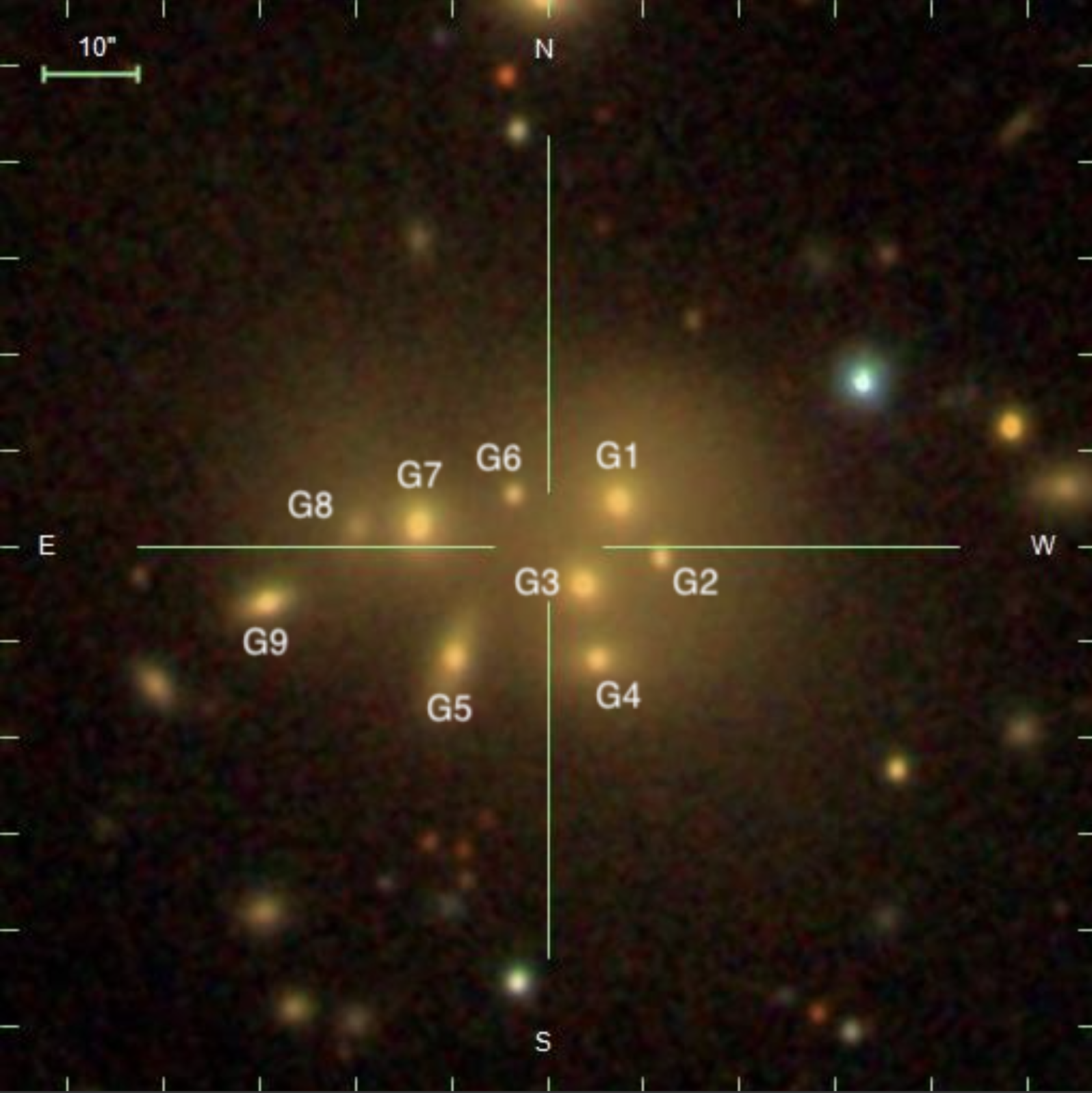
To better understand how the galaxies form, it is crucial to observe them when they are evolving. The brightest cluster galaxies (BCGs) are thought to evolve into the most luminous and massive galaxies in the Universe through multiple merger events. These galaxies are located at the core of their galaxy cluster and are often radio-loud objects. The BCG at the core of the Abell 407 cluster (at a redshift of z=0.047) is a compact group of nine galaxies (an optical image of it is shown in Figure 1.), which is, to our knowledge, the most compact and richest system of galaxies known to date at similar redshifts. Read more.
A JVLA, LOFAR, e-Merlin, VLBA and EVN study of RBS 797: can binary supermassive black holes explain the outburst history of the central radio galaxy?
Francesco Ubertosi
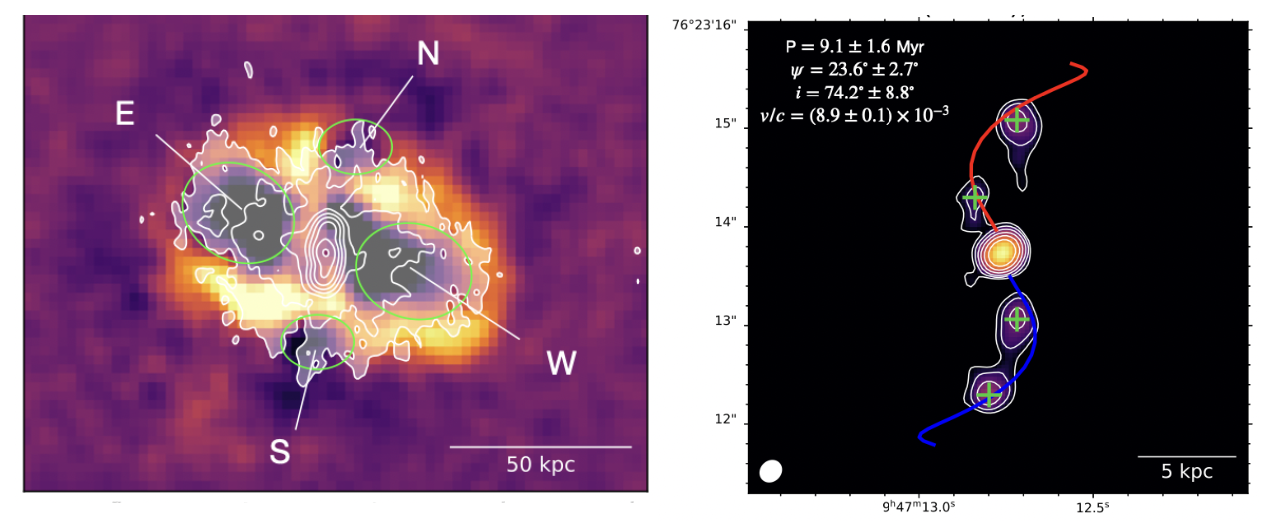
Supermassive black holes (SMBHs) can experience multiple phases of activity as Active Galactic Nuclei (AGN) over time. There are cases in which the SMBH drives a new pair of jets before the previous lobes completely fade, which can result in multiple pairs of radio lobes around a single AGN (e.g., Saikia & Jamrozy 2009). A variety of radio sources have so far questioned the idea that SMBH-driven jets are always stable, straight, linear outflows. Several radio galaxies show multiple misaligned radio lobes or twisting relativistic jets, even though it is still unclear which mechanism is responsible for the changes in jet axis (e.g., Krause et al. 2019). Read more.
Small-scale Jets in the Rapidly Growing Supermassive Black Hole IZw1
Xiaolong Yang

Accretion of black holes at near- or super-Eddington rates is crucial for black hole growth and the co-evolution of supermassive black holes (SMBHs) and their host galaxies. However, the physics of accretion and jet–disk coupling in these extreme states remains poorly understood, largely due to the difficulty in detecting jets, which may emit weakly or intermittently. Read more.
Revealing a magnetic field’s morphology through polarised light
Georgios Filippos Paraschos

Directly resolving the shadow of a supermassive black hole (SMBH) and the surrounding medium of the host galaxy has only been possible for a particular set of radio sources (EHTC et al., 2019; Event Horizon Telescope Collaboration et al., 2021). For all other sources, polarimetric observations are key for studying energy extraction from black holes (Paraschos et al., 2022) and for revealing magnetic field structures in jets, providing critical insights into their formation mechanism. Read more.
A new edition of the EVN seminars is on the way
The European VLBI Network (EVN) has successfully concluded its latest edition of online seminars, showcasing the power of Very Long Baseline Interferometry (VLBI) in astronomical research. Do not miss the new edition of EVN Seminars that will start in the fall. Meanwhile you can rewatch all the previous seminars. Read more.
Second EVN e-workshop saw high participation
JIVE organised on 25 April 2024 the second online training event for using the EVN with an aim to support first-time users of the network. A total of 105 participants, spread over 33 countries, registered for the training. Read more.
Short report on the June 2024 EVN TOG meeting
The EVN Technical and Operations Group (TOG) met in Göteborg, Sweden, on 25/26 June 2024. The TOG itself was held on 25 June. Topics of interest besides the usual were the state of technical capabilities for increased bandwidth: wide C/X band and tri-band (K/Q/W) receivers, DBBC3 status, and if the recorder is capable of > 8 Gpbs, e-VLBI with the DBBC3 and updates on some recent developments such as 8 bits per sample data recordings and correlation. The second day was a half day, spent at Onsala Space Observatory, and featured lectures on DBBC3 operations at Onsala and a full e-VLBI/e-shipping recap, and a tour of the observatory site.
News from ORP
The second science talk session took place on June 5th, featuring Gyula Józsa and Lukasz Wyrzykowski. The “ORP Science Talks” consist of Zoom-based events that offer researchers from the ORP community and beyond the opportunity to present their work and exchange ideas. The next session is scheduled for September 25th at 11 a.m. CEST via this Zoom link. If you'd like to watch the first two talks, click here for #1 and here for #2.
News from Radioblocks
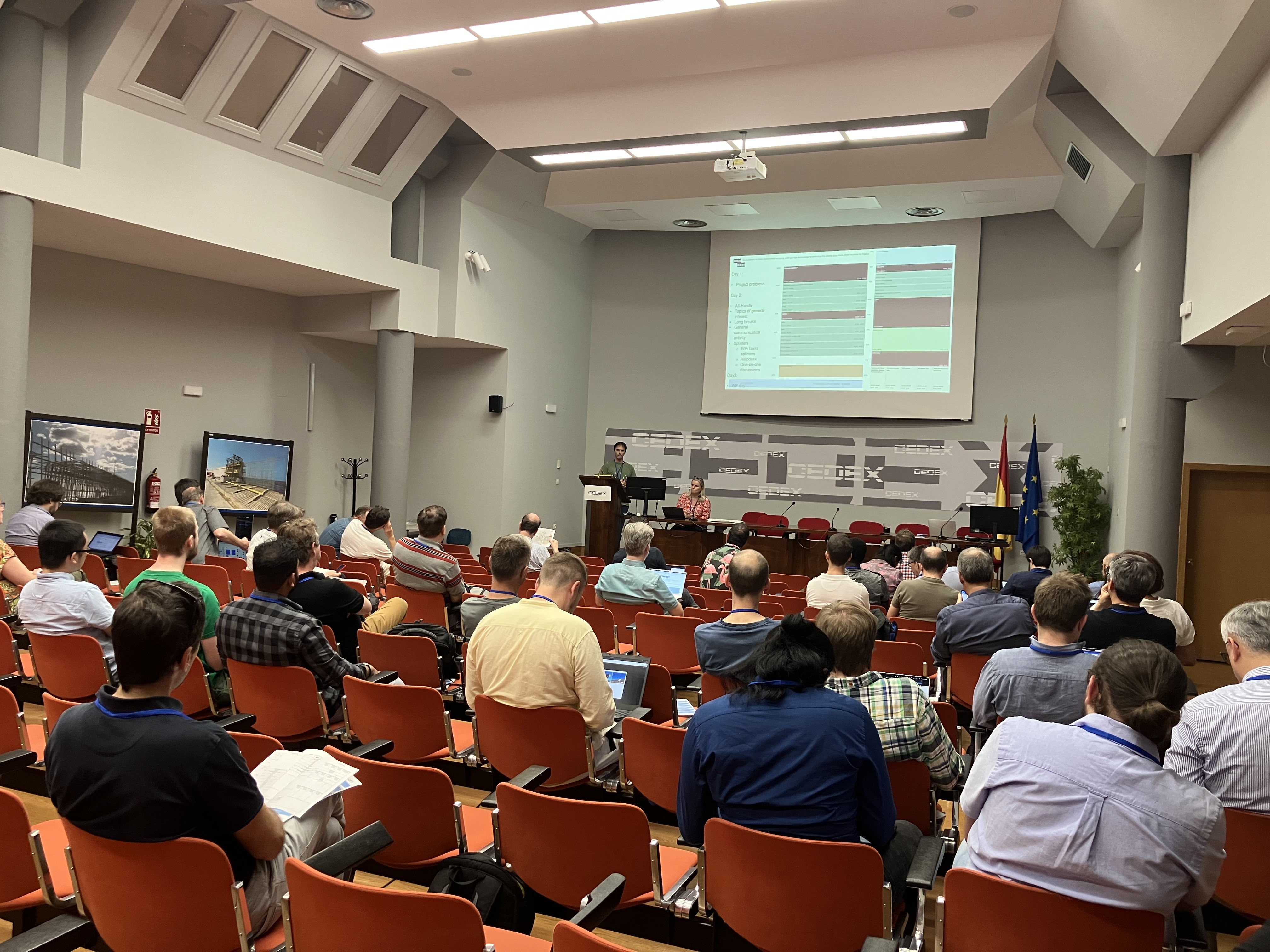
From Tuesday, June 4, to Thursday, June 6, the first all-hands meeting of Radioblocks was held in Madrid, Spain. This meeting was crucial for sharing and discussing the advancements made through the Radioblocks collaboration. The program included a series of engaging talks on the exciting achievements from the project's first year, along with several splinter meetings. The creativity of the project members showed itself in a new light during the one-and-a-half-hour social activity, as they took on the role of the project’s communicators. They participated enthusiastically, and the results of this enjoyable activity will be incorporated into the communication materials developed in the coming months.
A few weeks after the meeting, the European Union's review of Periodic Report #1 strongly acknowledged the progress and potential of the project contributors: "The consortium has fully achieved its objectives and milestones for this period", it read. "It is extremely strong scientifically and technically".
-
The European VLBI Network Symposium, Bonn, Germany, September 2-6, 2024.
-
The 53rd Young European Radio Astronomers Conference (YERAC 2024), Madrid, Spain, September 3-6, 2024.
-
The Tenth European Radio Interferometry School (ERIS 2024), Granada, Spain, September 30-October 4, 2024.
EVN/JIVE newsletter editorial team: Agnieszka Slowikowska (JIVE Director), Zsolt Paragi (JIVE Head of User Support), Ioanna Kazakou (JIVE Communications Officer).
For any enquiries about the newsletter, please contact communications@jive.eu.
